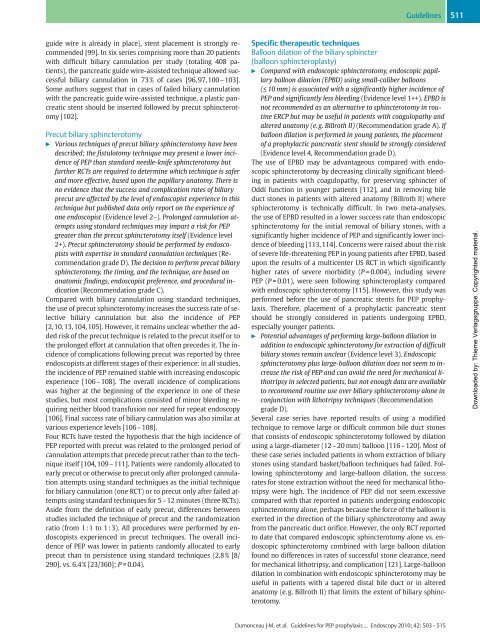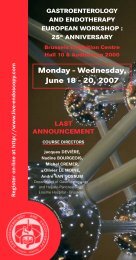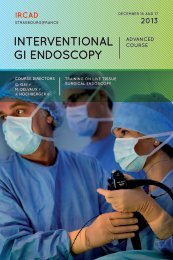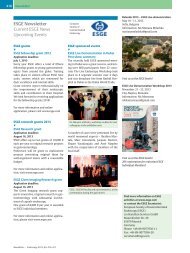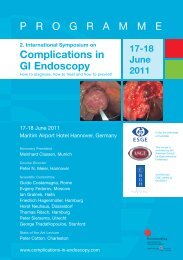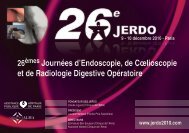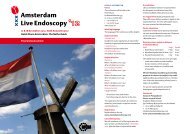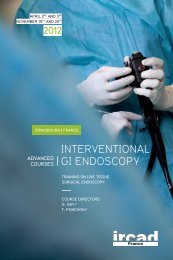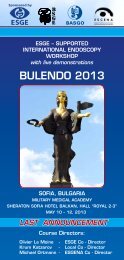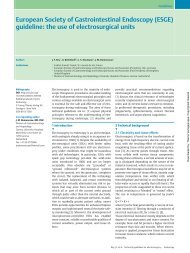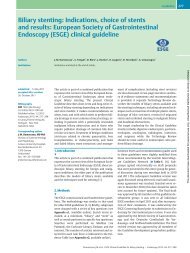(ESGE) Guideline: Prophylaxis of post-ERCP ... - ResearchGate
(ESGE) Guideline: Prophylaxis of post-ERCP ... - ResearchGate
(ESGE) Guideline: Prophylaxis of post-ERCP ... - ResearchGate
You also want an ePaper? Increase the reach of your titles
YUMPU automatically turns print PDFs into web optimized ePapers that Google loves.
guide wire is already in place), stent placement is strongly recommended<br />
[99]. In six series comprising more than 20 patients<br />
with difficult biliary cannulation per study (totaling 408 patients),<br />
the pancreatic guide wire-assisted technique allowed successful<br />
biliary cannulation in 73 % <strong>of</strong> cases [96, 97,100 – 103].<br />
Some authors suggest that in cases <strong>of</strong> failed biliary cannulation<br />
with the pancreatic guide wire-assisted technique, a plastic pancreatic<br />
stent should be inserted followed by precut sphincterotomy<br />
[102].<br />
Precut biliary sphincterotomy<br />
" Various techniques <strong>of</strong> precut biliary sphincterotomy have been<br />
described; the fistulotomy technique may present a lower incidence<br />
<strong>of</strong> PEP than standard needle-knife sphincterotomy but<br />
further RCTs are required to determine which technique is safer<br />
and more effective, based upon the papillary anatomy. There is<br />
no evidence that the success and complication rates <strong>of</strong> biliary<br />
precut are affected by the level <strong>of</strong> endoscopist experience in this<br />
technique but published data only report on the experience <strong>of</strong><br />
one endoscopist (Evidence level 2–). Prolonged cannulation attempts<br />
using standard techniques may impart a risk for PEP<br />
greater than the precut sphincterotomy itself (Evidence level<br />
2+). Precut sphincterotomy should be performed by endoscopists<br />
with expertise in standard cannulation techniques (Recommendation<br />
grade D). The decision to perform precut biliary<br />
sphincterotomy, the timing, and the technique, are based on<br />
anatomic findings, endoscopist preference, and procedural indication<br />
(Recommendation grade C).<br />
Compared with biliary cannulation using standard techniques,<br />
the use <strong>of</strong> precut sphincterotomy increases the success rate <strong>of</strong> selective<br />
biliary cannulation but also the incidence <strong>of</strong> PEP<br />
[2, 10,13, 104, 105]. However, it remains unclear whether the added<br />
risk <strong>of</strong> the precut technique is related to the precut itself or to<br />
the prolonged effort at cannulation that <strong>of</strong>ten precedes it. The incidence<br />
<strong>of</strong> complications following precut was reported by three<br />
endoscopists at different stages <strong>of</strong> their experience: in all studies,<br />
the incidence <strong>of</strong> PEP remained stable with increasing endoscopic<br />
experience [106 – 108]. The overall incidence <strong>of</strong> complications<br />
was higher at the beginning <strong>of</strong> the experience in one <strong>of</strong> these<br />
studies, but most complications consisted <strong>of</strong> minor bleeding requiring<br />
neither blood transfusion nor need for repeat endoscopy<br />
[106]. Final success rate <strong>of</strong> biliary cannulation was also similar at<br />
various experience levels [106 – 108].<br />
Four RCTs have tested the hypothesis that the high incidence <strong>of</strong><br />
PEP reported with precut was related to the prolonged period <strong>of</strong><br />
cannulation attempts that precede precut rather than to the technique<br />
itself [104, 109 – 111]. Patients were randomly allocated to<br />
early precut or otherwise to precut only after prolonged cannulation<br />
attempts using standard techniques as the initial technique<br />
for biliary cannulation (one RCT) or to precut only after failed attempts<br />
using standard techniques for 5 – 12 minutes (three RCTs).<br />
Aside from the definition <strong>of</strong> early precut, differences between<br />
studies included the technique <strong>of</strong> precut and the randomization<br />
ratio (from 1 : 1 to 1 : 3). All procedures were performed by endoscopists<br />
experienced in precut techniques. The overall incidence<br />
<strong>of</strong> PEP was lower in patients randomly allocated to early<br />
precut than to persistence using standard techniques (2.8% [8/<br />
290]. vs. 6.4 % [23/360]; P=0.04).<br />
<strong>Guideline</strong>s 511<br />
Specific therapeutic techniques<br />
Balloon dilation <strong>of</strong> the biliary sphincter<br />
(balloon sphincteroplasty)<br />
" Compared with endoscopic sphincterotomy, endoscopic papillary<br />
balloon dilation (EPBD) using small-caliber balloons<br />
(≤ 10 mm) is associated with a significantly higher incidence <strong>of</strong><br />
PEP and significantly less bleeding (Evidence level 1++). EPBD is<br />
not recommended as an alternative to sphincterotomy in routine<br />
<strong>ERCP</strong> but may be useful in patients with coagulopathy and<br />
altered anatomy (e.g. Billroth II) (Recommendation grade A).If<br />
balloon dilation is performed in young patients, the placement<br />
<strong>of</strong> a prophylactic pancreatic stent should be strongly considered<br />
(Evidence level 4, Recommendation grade D).<br />
The use <strong>of</strong> EPBD may be advantageous compared with endoscopic<br />
sphincterotomy by decreasing clinically significant bleeding<br />
in patients with coagulopathy, for preserving sphincter <strong>of</strong><br />
Oddi function in younger patients [112], and in removing bile<br />
duct stones in patients with altered anatomy (Billroth II) where<br />
sphincterotomy is technically difficult. In two meta-analyses,<br />
the use <strong>of</strong> EPBD resulted in a lower success rate than endoscopic<br />
sphincterotomy for the initial removal <strong>of</strong> biliary stones, with a<br />
significantly higher incidence <strong>of</strong> PEP and significantly lower incidence<br />
<strong>of</strong> bleeding [113, 114]. Concerns were raised about the risk<br />
<strong>of</strong> severe life-threatening PEP in young patients after EPBD, based<br />
upon the results <strong>of</strong> a multicenter US RCT in which significantly<br />
higher rates <strong>of</strong> severe morbidity (P=0.004), including severe<br />
PEP (P=0.01), were seen following sphincteroplasty compared<br />
with endoscopic sphincterotomy [115]. However, this study was<br />
performed before the use <strong>of</strong> pancreatic stents for PEP prophylaxis.<br />
Therefore, placement <strong>of</strong> a prophylactic pancreatic stent<br />
should be strongly considered in patients undergoing EPBD,<br />
especially younger patients.<br />
" Potential advantages <strong>of</strong> performing large-balloon dilation in<br />
addition to endoscopic sphincterotomy for extraction <strong>of</strong> difficult<br />
biliary stones remain unclear (Evidence level 3). Endoscopic<br />
sphincterotomy plus large-balloon dilation does not seem to increase<br />
the risk <strong>of</strong> PEP and can avoid the need for mechanical lithotripsy<br />
in selected patients, but not enough data are available<br />
to recommend routine use over biliary sphincterotomy alone in<br />
conjunction with lithotripsy techniques (Recommendation<br />
grade D).<br />
Several case series have reported results <strong>of</strong> using a modified<br />
technique to remove large or difficult common bile duct stones<br />
that consists <strong>of</strong> endoscopic sphincterotomy followed by dilation<br />
using a large-diameter (12 – 20 mm) balloon [116 – 120]. Most <strong>of</strong><br />
these case series included patients in whom extraction <strong>of</strong> biliary<br />
stones using standard basket/balloon techniques had failed. Following<br />
sphincterotomy and large-balloon dilation, the success<br />
rates for stone extraction without the need for mechanical lithotripsy<br />
were high. The incidence <strong>of</strong> PEP did not seem excessive<br />
compared with that reported in patients undergoing endoscopic<br />
sphincterotomy alone, perhaps because the force <strong>of</strong> the balloon is<br />
exerted in the direction <strong>of</strong> the biliary sphincterotomy and away<br />
from the pancreatic duct orifice. However, the only RCT reported<br />
to date that compared endoscopic sphincterotomy alone vs. endoscopic<br />
sphincterotomy combined with large balloon dilation<br />
found no differences in rates <strong>of</strong> successful stone clearance, need<br />
for mechanical lithotripsy, and complication [121]. Large-balloon<br />
dilation in combination with endoscopic sphincterotomy may be<br />
useful in patients with a tapered distal bile duct or in altered<br />
anatomy (e.g. Billroth II) that limits the extent <strong>of</strong> biliary sphincterotomy.<br />
Dumonceau J-M. et al. <strong>Guideline</strong>s for PEP prophylaxis … Endoscopy 2010; 42: 503 –515<br />
Downloaded by: Thieme Verlagsgruppe. Copyrighted material.


